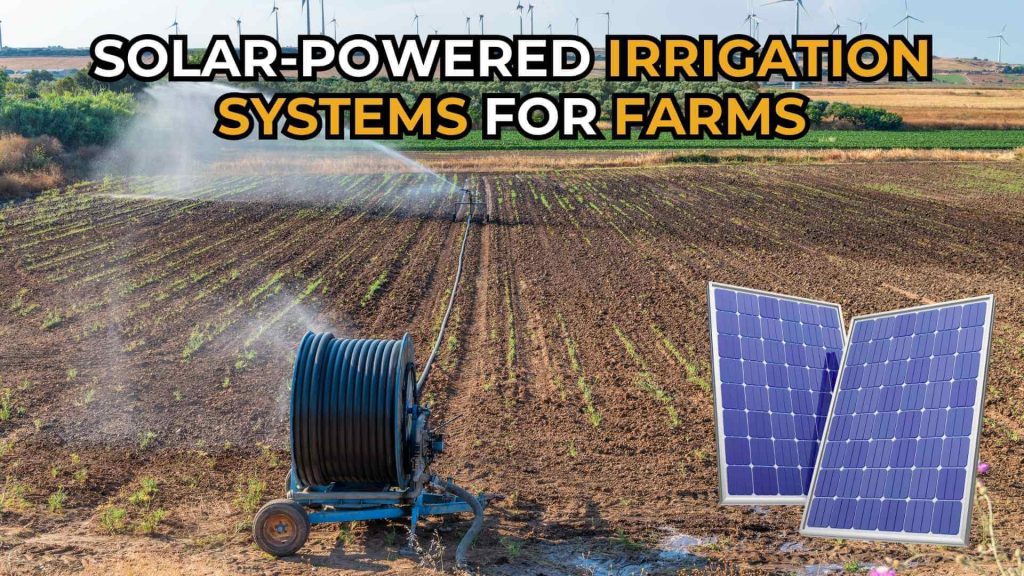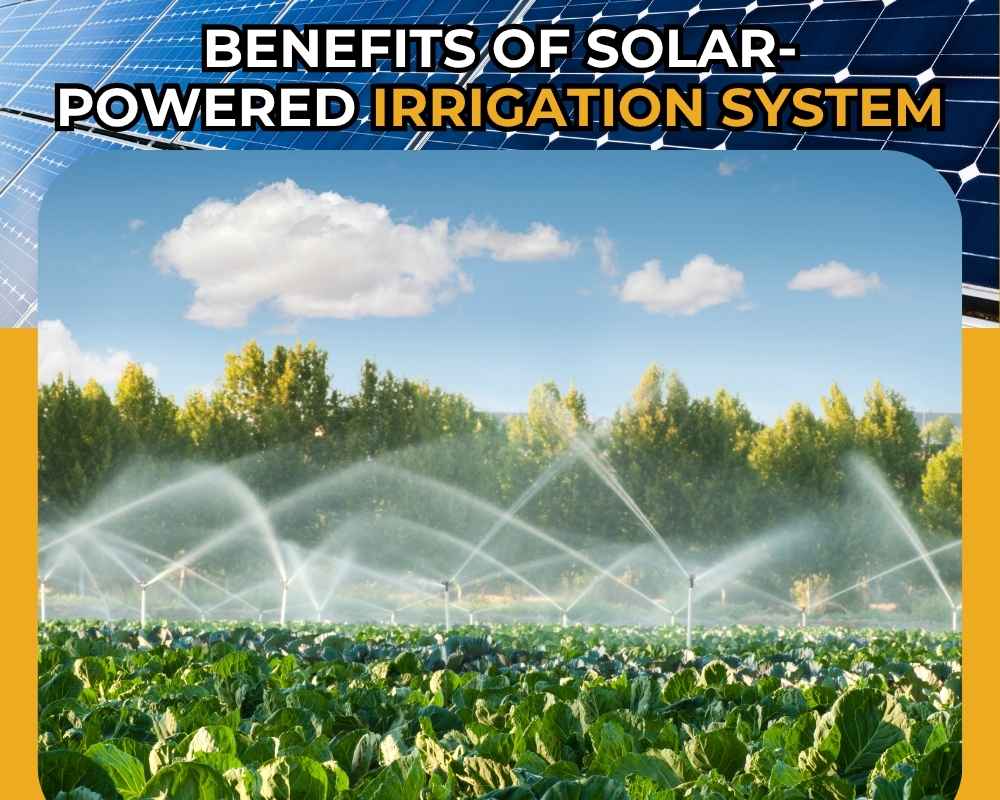We are dedicated to promoting sustainable farming practices and enhancing agricultural efficiency through innovative energy solutions. California’s diverse agricultural industry faces many challenges, including water scarcity, rising energy costs, and environmental concerns. Solar-powered irrigation systems provide a sustainable, cost-effective solution to address these challenges, ensuring California farmers can thrive in a more eco-conscious and energy-efficient environment.

Understanding Solar-Powered Irrigation Systems
What Are Solar-Powered Irrigation Systems?
Solar-powered irrigation systems harness the energy of the sun to power water pumps used for irrigation. These systems utilize photovoltaic (PV) panels to convert sunlight into electricity, which is then used to pump water from sources like wells, rivers, or reservoirs. Solar energy is an ideal solution for irrigation in regions with abundant sunlight and limited access to the electrical grid. By adopting this technology, farmers can reduce energy costs, lower their carbon footprint, and improve water usage efficiency.
Key Components of Solar-Powered Irrigation Systems
A typical solar-powered irrigation system includes several key components that work together to ensure optimal performance:
- Photovoltaic Panels: These panels capture sunlight and convert it into electricity to power the irrigation system.
- Inverters: The electricity generated by the panels is in the form of direct current (DC), which is converted to alternating current (AC) by inverters for use in the irrigation system.
- Water Pumps: These pumps draw water from wells, rivers, or reservoirs to irrigate crops.
- Control Systems: These systems manage water flow, regulate irrigation schedules, and monitor system performance for efficiency.
Benefits of Solar-Powered Irrigation Systems

1. Cost Savings and Financial Viability
One of the primary benefits of solar-powered irrigation systems is the significant cost savings for farmers. Traditionally, farmers have relied on grid electricity or diesel-powered pumps to irrigate their crops. These systems can be costly to run, especially during peak seasons when water demands are high. Solar-powered systems, on the other hand, eliminate the need for expensive electricity or fuel, offering long-term savings on energy costs.
According to the California Department of Food and Agriculture (CDFA), farmers who adopt renewable energy solutions, such as solar-powered pumps, can access grants through programs like the State Water Efficiency & Enhancement Program (SWEEP) to reduce greenhouse gas emissions, save water, and enhance their operations.
2. Environmental Benefits and Water Conservation
California is facing a water scarcity crisis that is exacerbated by climate change and growing agricultural demands. By utilizing solar-powered irrigation systems, farmers can implement water-saving irrigation practices that ensure crops receive the right amount of water without excessive waste. These systems also reduce the reliance on fossil fuels, lowering the carbon footprint of agricultural operations.
Incorporating efficient irrigation technologies helps conserve water, promote sustainability, and align with California’s environmental goals. The California Energy Commission’s Renewable Energy for Agriculture Program (REAP) supports the installation of solar-powered systems to reduce greenhouse gas emissions in farming.
3. Energy Independence and Off-Grid Solutions
For farmers located in remote or rural areas where access to the grid is limited or unreliable, solar-powered irrigation systems offer the added advantage of energy independence. These systems provide an off-grid solution, allowing farmers to generate their own electricity and operate irrigation systems without relying on the grid or diesel generators. This enhances resilience to power outages and reduces dependency on external energy sources.
4. Efficiency, Automation, and Smart Irrigation
Modern solar-powered irrigation systems incorporate smart irrigation technologies, such as soil moisture sensors, weather-based controllers, and automated scheduling systems. These technologies optimize water usage by ensuring that crops are only irrigated when necessary, reducing water wastage and improving overall irrigation efficiency.
By automating irrigation schedules and integrating real-time data, farmers can better manage water resources, resulting in more sustainable farming practices and improved crop yields.
Implementing Solar-Powered Irrigation Systems
Assessing Feasibility and Site Evaluation
Before installing a solar-powered irrigation system, farmers must assess several key factors to ensure the system is suitable for their specific needs:
- Solar Irradiance: The amount of sunlight the area receives will impact the system’s energy production. A proper solar site evaluation will help determine the ideal size of the system.
- Water Requirements: Understanding the volume of water needed for irrigation is critical to sizing the pumps and determining the amount of energy required.
- Infrastructure: Ensure the available space can accommodate the required solar panels, water pumps, and other system components.
System Design and Customization
Each farm has unique needs based on crop types, irrigation schedules, and water sources. Working with a professional solar provider, farmers can design a customized system that meets their specific requirements. This includes selecting the appropriate size and capacity of solar panels, pumps, and control systems.
Installation and Maintenance
Proper installation by certified professionals is essential for the efficient operation of the system. Once installed, regular maintenance is crucial to ensure the solar panels remain clean and free from debris, and the water pumps are in good working condition. Regular maintenance also extends the lifespan of the system and ensures it continues to operate efficiently.
Case Studies in California
1. Imperial Irrigation District
The Imperial Irrigation District (IID) in California is a key player in advancing renewable energy solutions for agriculture. IID has been instrumental in integrating solar-powered irrigation systems into the region’s agricultural operations. Through their support, farmers in the Imperial Valley have been able to reduce energy costs and conserve water, all while contributing to the state’s renewable energy goals.
2. Westlands Solar Park
Westlands Solar Park, located in Kings County, California, is one of the largest solar power projects in the U.S. This park is built on land that was previously considered unsuitable for farming. By integrating solar power with agricultural operations, Westlands Solar Park is helping to demonstrate how solar energy can be used in farming to create a more sustainable future.
Conclusion
Solar-powered irrigation systems offer a sustainable, cost-effective solution for California farmers facing challenges related to water scarcity, high energy costs, and environmental concerns. By transitioning to solar energy solutions, farmers can significantly reduce their reliance on traditional power sources, conserve water, and lower their carbon footprint.

At Gecko Solar Energy, we are dedicated to supporting farmers in California by providing expert consultation, customized solar system designs, and reliable installation services. With the right solar-powered irrigation system, farmers can achieve greater efficiency, increase profitability, and contribute to a greener, more sustainable future.
For more information or to schedule a consultation, contact us at +1 619 826 6600 or hello@geckosolarenergy.us.



